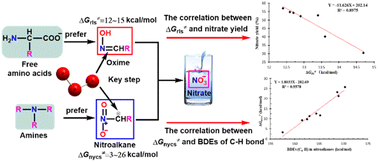Nitrate as a potential surrogate parameter for abatement of micropollutants, oxidant exposure, and characterizing oxidant-reactive DON during ozonation has attracted extensive attention, however, understanding of its formation mechanisms is still limited. In this study, nitrate formation mechanisms from amino acids (AAs) and amines during ozonation were investigated by the DFT method. The results indicate that N-ozonation initially occurs to produce competitive nitroso- and N,N-dihydroxy intermediates, and the former is preferred for both AAs and primary amines. Then, oxime and nitroalkane are generated during further ozonation, which are the important last intermediate products for nitrate formation from the respective AAs and amines. Moreover, the ozonation of the above important intermediates is the nitrate yield-controlling step, where the relatively higher reactivity of the C![[double bond, length as m-dash]](https://www.rsc.org/images/entities/char_e001.gif) N moiety in the oxime compared to the general Cα atom in the nitroalkane explains why the nitrate yields of most AAs are higher than those from general amines, and it is the larger number of released Cα− anions, which are the real reaction sites attacked by ozone, that leads to the higher nitrate yield for nitroalkane with an electron-withdrawing group bound to the Cα atom. The good relationship between nitrate yields and activation free energies of the rate-limiting step (ΔG≠rls) and nitrate yield-controlling step (ΔG≠nycs) for the respective AAs and amines verifies the reliability of the proposed mechanisms. Additionally, the bond dissociation energy of Cα–H in the nitroalkanes formed from amines was found to be a good parameter to evaluate the reactivity of the amines. The findings here are helpful for further understanding nitrate formation mechanisms and predicting nitrate precursors during ozonation.
N moiety in the oxime compared to the general Cα atom in the nitroalkane explains why the nitrate yields of most AAs are higher than those from general amines, and it is the larger number of released Cα− anions, which are the real reaction sites attacked by ozone, that leads to the higher nitrate yield for nitroalkane with an electron-withdrawing group bound to the Cα atom. The good relationship between nitrate yields and activation free energies of the rate-limiting step (ΔG≠rls) and nitrate yield-controlling step (ΔG≠nycs) for the respective AAs and amines verifies the reliability of the proposed mechanisms. Additionally, the bond dissociation energy of Cα–H in the nitroalkanes formed from amines was found to be a good parameter to evaluate the reactivity of the amines. The findings here are helpful for further understanding nitrate formation mechanisms and predicting nitrate precursors during ozonation.
